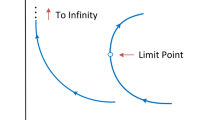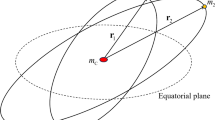Abstract
Formulas for the time of orbital flight in terms of the kinematic parameters are developed, and a kinematic theorem of orbital isochronism is introduced. Through this new theorem, the connection between the celebrated Lambart's theorem and the rather obscure theorem of Hamilton's hodographic isochronism is demonstrated, and the significance and implications of the latter are explored. In the light of Hamilton's hodographic representation, the characteristic features of an isochronal and isoenergetic family of Keplerian trajectories are observed, and a simple geometric method for the construction of such a family is proposed. Finally, Hamilton's time integral is briefly treated, resulting in another set of useful formulas for the time of flight.
Similar content being viewed by others
References
Battin, R. H.: 1964,Astronautical Guidance, McGraw-Hill, pp. 70–82 and 107–09.
Battin, R. H.: 1965, ‘Orbital Boundary Value Problems’, inAAS Symposium on Unmanned Exploration of the Solar System, Denver, Colorado, Feb. 1965.
Battin, R. H.: 1968, ‘A New Solution, for Lambert's Problem’, in19th International Astronautical Congress, New York.
Cayley, A.: 1857, ‘A Demonstration of Sir W. R. Hamilton's Theorem of the Isochronism of the Circular Hodograph’,Phil. Mag. 14, 427–30.
Droop, H. R.: 1857, ‘On the Isochronism of the Circular Hodograph’,Quart. J. Pure Appl. Math. 1, 374–8.
Gedeon, G. S.: 1961, ‘Lambertian Mechanics’,Proc. 12th International Astronautical Congress, Washington, D. C., Vol. I, Academic Press pp. 172–90 (1963).
Godal, Th.: 1960, ‘Conditions of Compatibility of Terminal Positions and Velocities’,Proc. 11th International Astronautical Congress, Stokholm.
Godal, Th.: 1967, ‘Natural Terminal Velocity Components’,Arkiv Astron. Roy. Swedish Acad. of Science.
Hamilton, Sir W. R.: 1845–1847, ‘The Hodograph, or a New Method of Expressing in Symbolic Language the Newtonian Law of Attraction’,Proc. Roy. Irish Acad. 3, 344–53.
Hamilton, W. R.: 1847, ‘On a Theorem of Hodographic Isochronism’,Proc. Roy. Irish Acad. 3, 417.
Hamilton, W. R.: 1847, ‘On a Theorem of Anthodographic Isochronism’,Proc. Roy. Irish Acad. 3, 465.
Hamilton, W. R.: 1940, ‘Hodographic and Anthodographic Isochronism’, Math. Papers of Sir William Rowen Hamilton,Royal Irish Acad., p. 630.
Hamilton, Sir W. R. 1901,Elements of Quaterion, Vol. II, Longmans, Green & Co., pp. 308–20.
Johnson, R. A.: 1929,Advanced Euclidean Geometry, Houghton Mifflin Co. (Dover, 1960), pp. 34–42, 100–05.
Lancaster, E. R. and Blanchard, R. C.: 1969,A Unified Form of Lambert's Theorem, NASA TN D-5368.
Pitkin, E. T.: ‘A General Solution of the Lambert Problem’,J. Astron. Sci., Oct. 1968.
Sun, F. T.: 1961,On the Hodograph, Method for Solution of Orbit Problems, Proc. 12th International Astronautical Congress, Washington, D. C., Vol. II, Academic Press (1963) pp. 879–915.
Sun, F. T.: 1965,Hodograph Analysis of the Free-Flight Trajectories Between Two Arbitrary Terminal Points, NASA CR-153, Washington, D.C.
Author information
Authors and Affiliations
Rights and permissions
About this article
Cite this article
Sun, F.T. On the orbital isochronism. Celestial Mechanics 3, 272–288 (1971). https://doi.org/10.1007/BF01231801
Received:
Issue Date:
DOI: https://doi.org/10.1007/BF01231801




